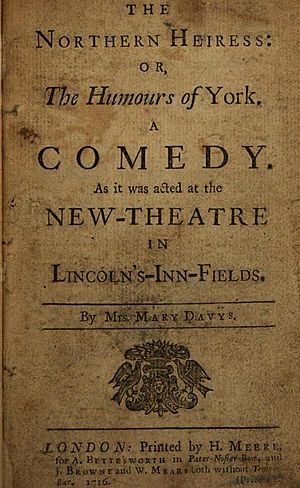Mary Davys facts for kids
Quick facts for kids
Mary Davys
|
|
|---|---|

Title page of Mary Davys' comedy The Northern Heiress, or, The Humours of York (1716)
|
|
| Born | 1674 Ireland |
| Died | 1732 |
| Resting place | Church of the Holy Sepulchre, Cambridge |
| Occupation | writer |
| Language | English |
| Years active | 1704—1727 |
| Notable work | The Reform'd Coquet (1724) |
| Spouse | Peter Davys |
|
|
|
Mary Davys (born around 1674, died 1732) was an important writer from Ireland. She wrote many novels and plays during her lifetime.
Contents
Early Life and Challenges
Mary Davys was born in Ireland. We don't know much about her early childhood. Some people, like the famous writer Jonathan Swift, suggested she grew up without much money.
She married Peter Davys, who was a teacher in Dublin. They had two daughters, but sadly, both of them passed away when they were very young. Even though she didn't come from a rich or famous family, Mary had some important friends.
After her husband died in 1698, Mary moved to London in 1700. She needed to find a way to support herself.
Starting a Writing Career
Mary Davys started her writing journey in the early 1700s. She published her first novel, The Amours of Alcippus and Lucippe, in 1704. The next year, she published "The Fugitive."
In 1716, her play, The Northern Heiress, or the Humours of York, was performed in London. This play was a comedy that looked at how people chose partners for marriage back then. It first showed in York in 1715. When it came to London, it ran for three nights. This was important for Mary because writers usually got the money from the third night's ticket sales.
She tried to make a successful writing career in London. In 1718, one of her novels, Familiar Letters Betwixt a Gentleman and a Lady, was printed under a different name. It wasn't until 1725 that it was published under her real name in her collected Works.
Around 1718, Mary decided to leave London. She moved to Cambridge and opened a coffee house. Many of her customers were students from St. John's College, Cambridge. She even thanked them in her book introductions for their support.
Famous Novels
While in Cambridge, Mary Davys wrote the novels she is most known for.
Her book The Reform'd Coquet (1724) is a great example of an "education novel." This type of story shows a main character who makes mistakes but then learns and changes for the better. In this book, a young woman learns to appreciate a good, sensible man.
Her Familiar Letters is another important work. It's an epistolary novel, which means it's told through letters between characters. This book made fun of the upper classes and their political ideas. It was published before other famous letter-based novels.
Later Life
Mary Davys lived in Cambridge until she passed away in 1732. She had been unwell for some time. She was buried in the Church of the Holy Sepulchre in Cambridge on July 5, 1732.
Her Works
Collected Books
- The works of Mrs. Davys: Consisting of, Plays, Novels, Poems, and Familiar Letters. Several of which never before publish'd. In two volumes. (London: H. Woodfall, 1725.)
Novels
- The amours of Alcippus and Lucippe. A novel. Written by A lady. (1704; later called The Lady's Tale in 1725)
- The Fugitive (1705; later called The Merry Wanderer in 1725)
- The Reform'd Coquet, or, Memoirs of Amoranda (1724. This book was very popular and had seven editions by 1760.)
- Familiar letters betwixt a gentleman and lady (published in her Works in 1725; first printed anonymously in 1718)
- The accomplish'd rake, or, Modern fine gentleman (1727)
- The False Friend, or the Treacherous Portuguese (written around 1704; published as The Cousins in 1725)
Plays
- The Northern Heiress, or, The Humours of York (First performed in York in 1715, then in London in 1716)
- The Self-Rival (Not published until her Works in 1725)
Poetry
- The Modern Poet (Not published until her Works in 1725)
See also
- List of 18th-century British working-class writers

